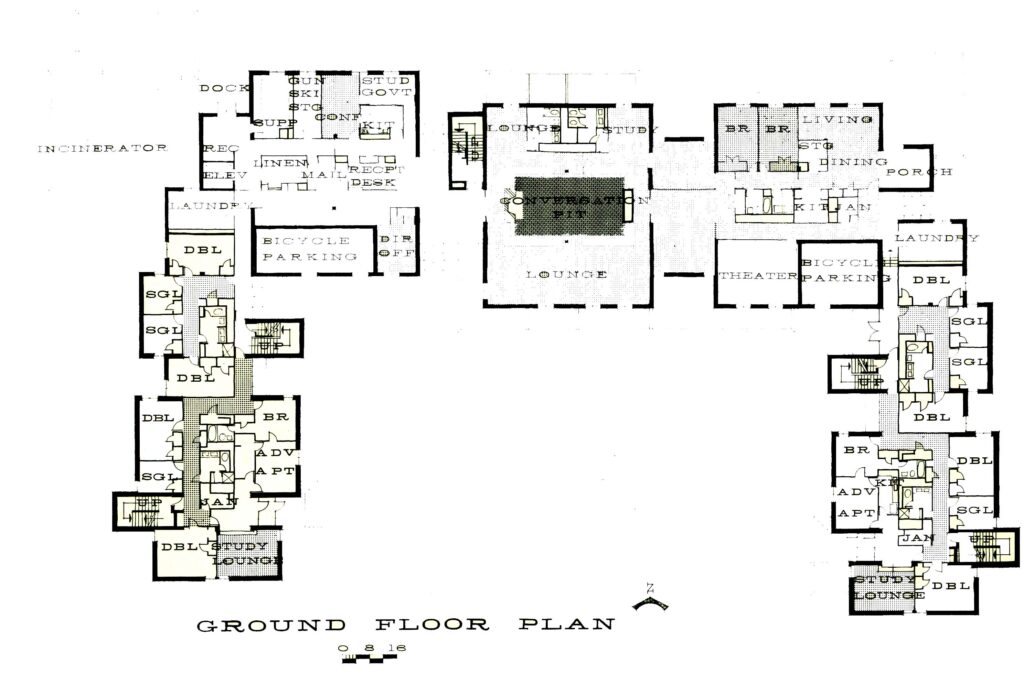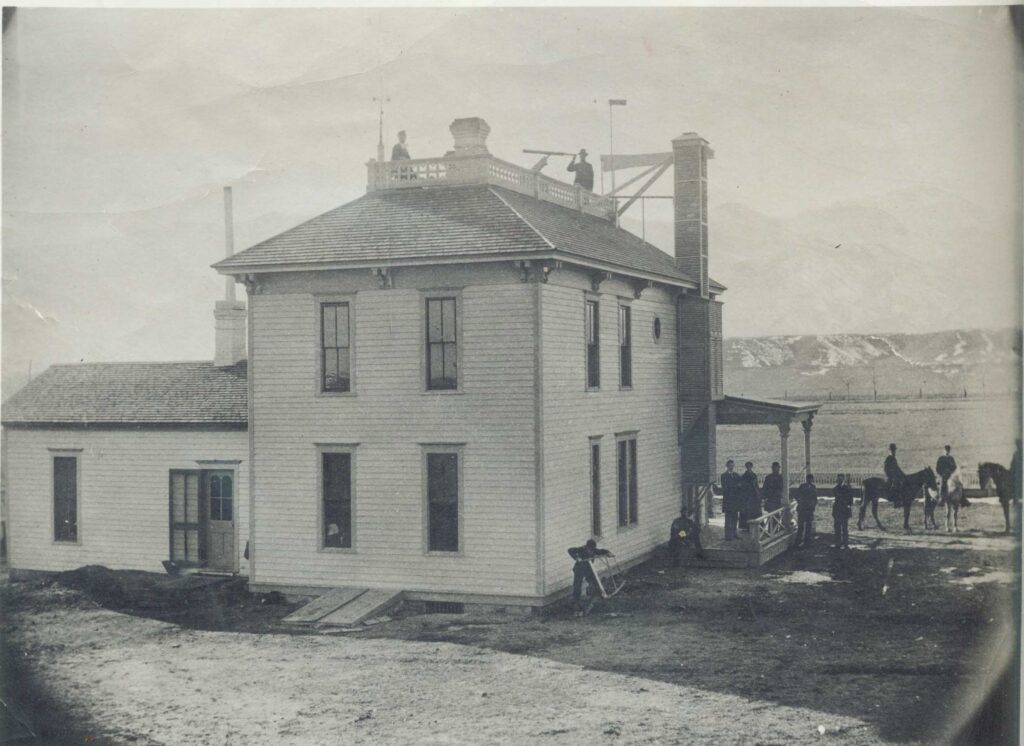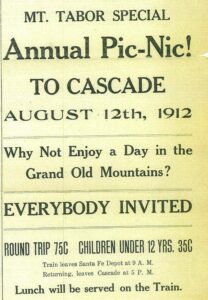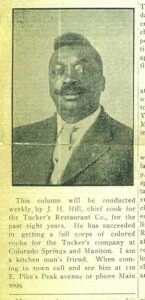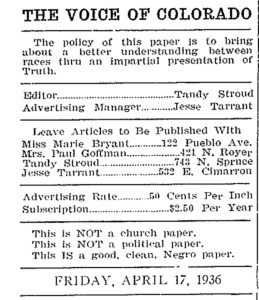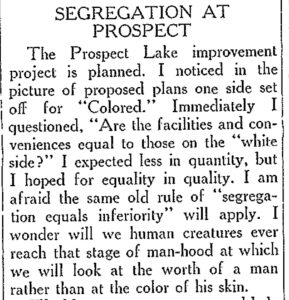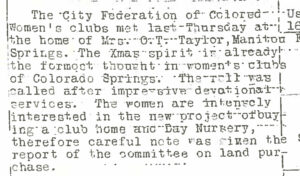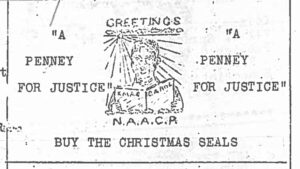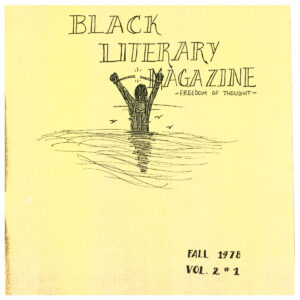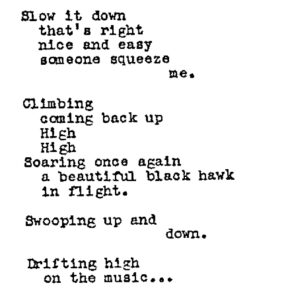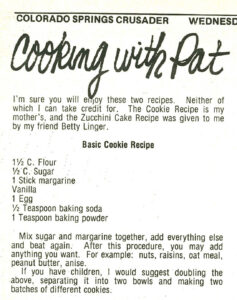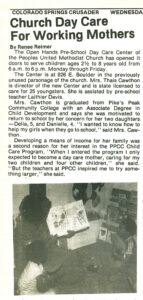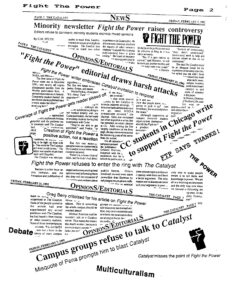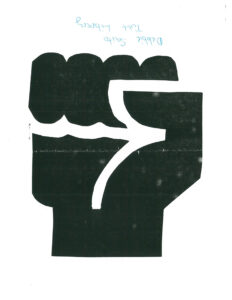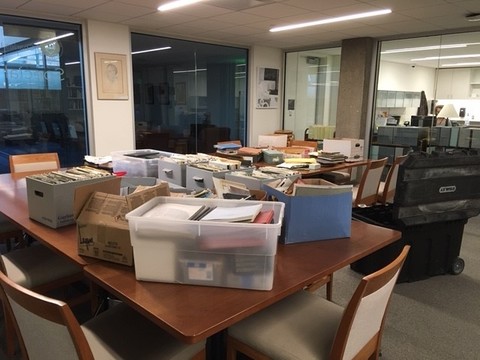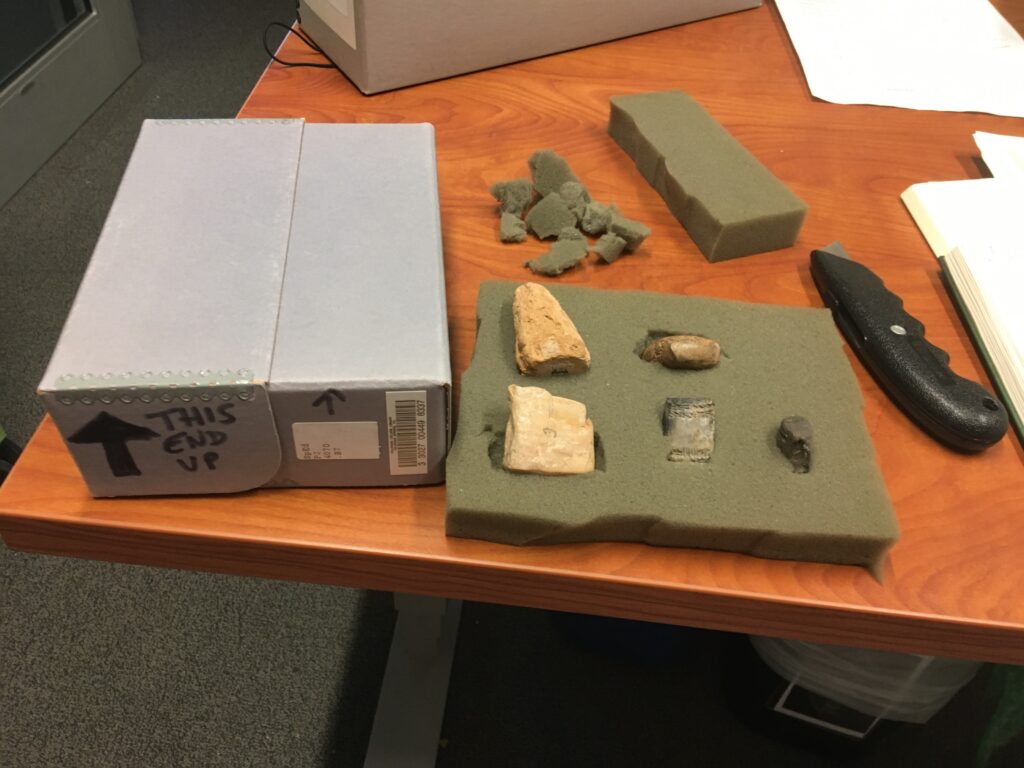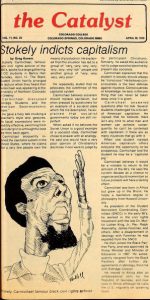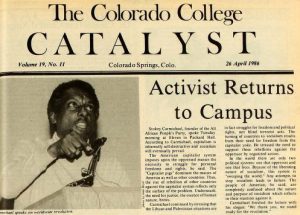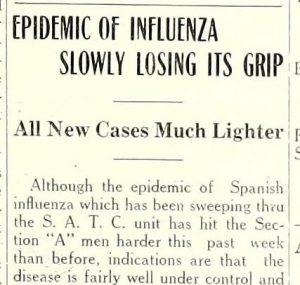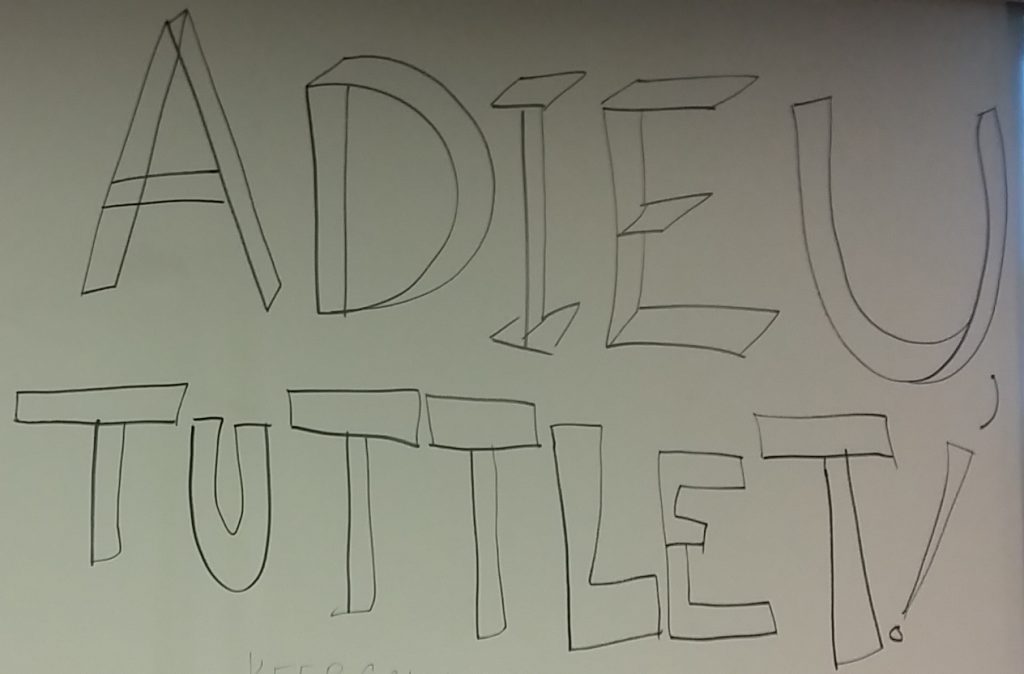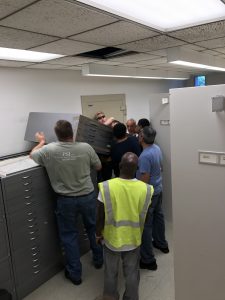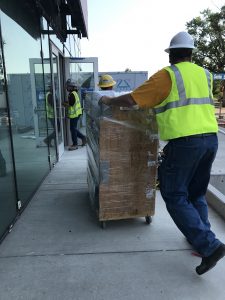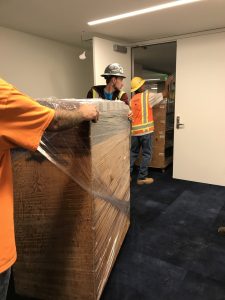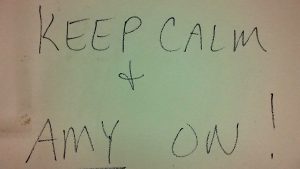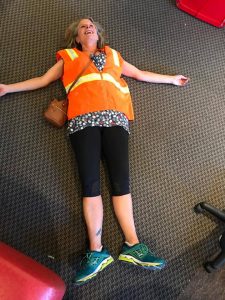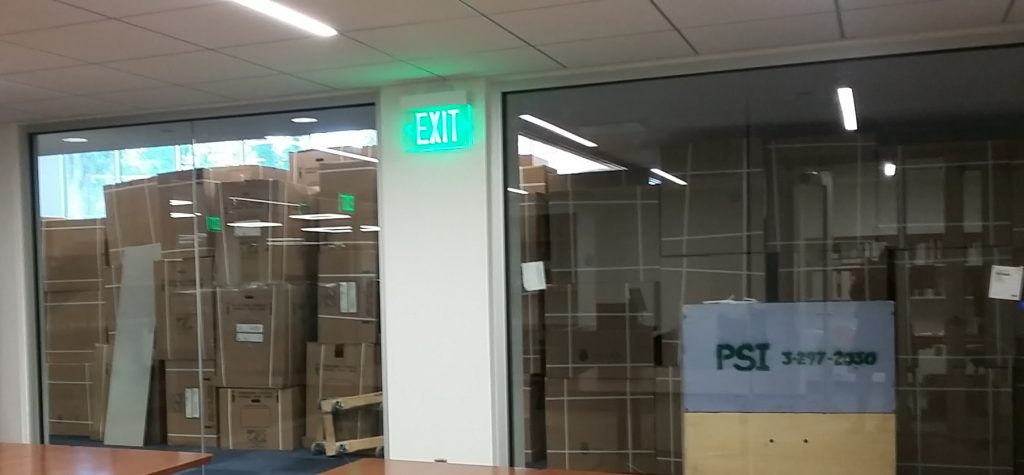Guest post by Tutt Library cataloging coordinator Clare Trissel. Thank you, Clare, for all your hard work uploading these images and creating metadata for them!
The expansive lantern slide collection, Southwestern Ruins, Villages, Pueblos and Missions, 1896-1940, is now available to peruse through Digital CC. The collection consists of 865 colored and black and white slides of New Mexico, Colorado, and Arizona Native American ruins, pueblos, missions, and artifacts, as well as general landscapes of the surroundings and portraits of individual residents. Collection highlights include a 60-image depiction of Navajoland including portraits of prominent Navajo men and women, 17 pictures of pueblo dances and 47 slides related to serpent worship.
Below, three of Clare’s favorite slides.
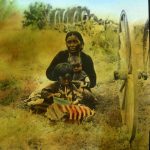
Navajo child with American flag: E10
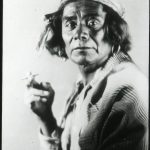
Lorenzo Herrera of Cochiti: H1
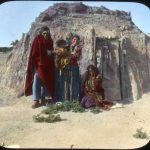
Navajo Reservation. Family and Hogan: G71
Finding aid to the collection:
Southwestern Ruins, Villages, Pueblos and Missions, 1896-1940 slide collection, SL97-36
Finding aid by Liz Smith, September, 1997. Updated in 2014 with a few details from a typed list found in a file. At some point prior to 1997 this collection was part of the Colorado College Collection at the Colorado Springs Fine Arts Center.
CONTENT AND SCOPE
This collection consists of 865 colored and black and white glass slides of New Mexico, Colorado, and Arizona Native American ruins, pueblos, missions, and artifacts, as well as general landscapes of the surroundings and portraits of individual residents. A large number of the slides are attributed to H. S. Poley, but it is not clear how many or which ones in particular are his work. The general category, “Missions of New Mexico,” name him as photographer on the index of Box A, but his name is not mentioned elsewhere in the collection.
Most of the slides are not dated, but those that are indicate years and occasionally, months, from the late 1880s to the 1930s. These dates are noted on the index in the top of each slide box. There are nine boxes in all with spaces for 100 slides in each.
In November, 1974, Andrew Taylor, a Colorado Springs photographer, made black and white negatives, contact sheets and work prints of the collection. These are numbered according to his own system for organizing the images and are stored in an archival box with the collection.
INVENTORY
BOX A
Missions of New Mexico
H.S. Poley, photographer
- Acoma (The Sky City). Mission at Acoma Pueblo.
- Cochiti 1915. Mission, Cochiti Pueblo (photo of a drawing)
- Cochiti. Mission and Plaza, Cochiti Pueblo.
- Cochiti. Later photo of Mission, Cochiti Pueblo.
- Cochiti. Circular Estufa.
- San Antonio de Isleta. Mission, Isleta Pueblo.
- San Agustin de Isleta. Corner of churchyard.
- Jemez. Mission, Jemez Pueblo.
- Nambe. Front, Mission, Nambe Pueblo.
- Nambe. Side View, Mission, Nambe Pueblo.
- Picuris – San Lorenzo. Mission, Picuris Pueblo.
- Pojoaque – San Francisco. Mission, Pojoaque Pueblo.
- Sandia – San Francisco. Mission, Sandia Pueblo.
- Sia (Zia). Mission, Sia Pueblo.
- San Felipe. Mission, San Felipe Pueblo.
- San Ildefonso. San Ildefonso Pueblo showing Mission Church.
- San Ildefonso. Mission & Convent, San Ildefonso.
- San Ildefonso. Courtyard of Convent.
- Santa Ana. Mission, Santa Ana Pueblo.
- Santa Clara. Mission, Santa Clara Pueblo. (taken from right)
- Santa Clara. Mission, Santa Clara Pueblo. (taken from left)
- Santo Domingo. Mission, Santo Domingo Pueblo. 1910.
- Santo Domingo. Estufa, Santo Domingo Pueblo.
- Taos – San Geronimo. 2nd Mission Church, Taos Pueblo.
- Los Ranchos de Taos. Mission, 1910.
- Los Ranchos de Taos. Mission, 1925.
- Los Ranchos de Taos. Interior, Mission.
- Los Ranchos de Taos. North Chapel.
- Zuni. Mission, Zuni Pueblo, N.M.
- Tesuque. Church, Tesuque Pueblo. 1910.
- Tesuque. Plaza and Church.
- Old San Miguel Church. Santa Fe, NM.
- Old San Miguel Church. Interior 1925.
- (List label incorrect) Ruins of Pecos Mission, Hwy. 87 to Las Vegas
- San Juan 1927. Interior of Mission.
- San Juan 1925. Grotto of Loudres Shrine, San Juan.
- San Juan 1906 (?). Church on Mission Site.
- Santa Cruz 1908. Mission Santa Cruz, N.M.
- Santa Cruz 1908. Mission of Holy Cross.
- Santa Cruz 1925. Mission Church.
- Penitente Morada. 1908. Near Santa Cruz, N.M.
- Penitente cross at burial & cactus. 1908. Santa Cruz.
- Chimayo. 1915. Santuario of Chimayo, N.M.
- Chimayo. 1915. Interior of Chimayo church dated about 1560.
Pueblos
Santa Clara
- Santa Clara Pueblo. 1908. Tuyo – Black Mesa.
- Cacti nearby. 1908.
- Peach orchards. 1908. Peach orchards, lane to Santa Clara.
- Old horse-feeding trough in plaza. 1908.
- Fence (unusual). 1910. Fenced Yard.
- Interior of home of Chief Pedro Cajete’s daughter. 1908. Swinging cradle, Santa Clara.
- Two-story house. 1908.
- Estufa (or kiva). 1908. Rectangular estufa.
- Well showing massive construction. 1908. Part of the Mission.
- Peach orchards. 1908.
- Woman with olla on her head. 1910.
- Epenfanio Tafoya, silversmith, Santa Clara. 1924.
- Chief Pedro Cajete. (with another man)
- Chief Pedro Cajete as medicine man at wedding of Miss Petra Sousa.
- Santa Clara Potters. 1910. Making pottery (with tourists looking on).
- Miss Otemina Najarito. 1908.
- Wheel of an old “Caretta” Spanish ox-cart. 1908.
San Juan
- San Juan – One side of the plaza. 1906.
- Estufa. 1906. Rectangular estufa.
- Women & children of San Juan. 1910.
- Women preparing chile pepper. 1908.
- Girls grinding corn. 1908. With metate.
- War Chief Juan Cruz & family.
- Juan Gabaldon and family. 1915.
- San Juan Indians – costumes and drum.
San Ildefonso
- Black Mesa, “Tuyo” Sacred Mountain. Tewa. Near San Ildefonso. 1908.
- San Ildefonso Pueblo. 1910.
- Entrance to the plaza. 1908.
- Home of the Governor. 1910.
- Interior of home of former governor. 1910.
- Two-story building. 1910. Estufa of Winter people.
- Juan Real Martinez, a former governor. 1910.
- Wagon shed or storage pavilion. 1908.
- Ovens. 1910. Preparing for baking.
- Rain priest of San Ildefonso kodaking his mother-in-law. 1910. Fun at San Ildefonso.
- Musicians for Buffalo Dance. 1910.
- Buffalo Dance. 1910. Leading off.
- Group of hunters. 1910. Buffalo Dance.
- Group of Buffalo (dancers). 1910. Buffalo Dance.
- Hunters in pursuit. 1910. Rounding up the Game, Buffalo Dance.
- Close view of hunters. 1910. Driving in the Game.
- A herder driving in the game. 1910. Herder & Buffalo.
- Herder in buckskin suit. 1910.
- Huntress in satin dress and Navajo necklace. Buffalo Dance. 1910.
- Hunter with bow and arrow. 1910.
- Buffalo hunter. 1910.
- Group of hunters. 1910.
- Eagle Dance. 1918.
Taos
- Mexican House. 1906. Taos, N.M.
- Apache basket-weaver at her wickiup. 1902. Taos, N.M.
- Looking up the Taos River. 1915. Taos Pueblo from the river.
- Roadway to Taos Pueblo. 1910.
- Southern exposure of South Pueblo. 1910. Adobe wall and sheds.
- Platform or shed – south pueblo. 1902.
- Central portion of south pueblo. 1910.
- Interior of a Taos home. 1902. South Pueblo.
BOX B
Taos (cont.)
- Estufa near east end of south pueblo. 1902. Looking down on top of e.
- Ventura – the Christ of Taos Pueblo. 1910.
- Juan and G. Mirabal. 1910.
- Indian bakery. 1902.
- Church – San Geronimo Fiesta. 1925. Present church at Taos.
- Interior of Church at Taos.
- Shadow of cross on the church. 1902. Churchyard.
- Ruined tower and churchyard (north). 1902. Ruins of old mission.
- Roadway to plaza of North pueblo. 1902. Relay race course.
- Decorations for the fiesta. 1902. Bower end of race course.
- East end of North Pueblo. 1902.
- Officials – South Pueblo. 1902. Gov. Berasl at Estufa.
- Runners at west end of course. 1910.
- Runners passing each other. 1902. Relay race.
- Victors returning to plaza. 1902. Runners from S. Pueblo.
- Antics of “Chifonetti.” 1902. Chifonetti climbing pole.
- Old footbridge at Taos. 1902.
- Taos through the trees. 1915. Taos as seen from the river.
Hopi
- Walpi, First or East Mesa. Looking south. Upper southern end.
- Spring at the foot of East Mesa.
- Walpi, looking SW to 2nd or Middle Mesa. Arizona.
- Walpi, Painted Desert, sheep corrals.
- Hano, a pueblo of Tewa Indians. On first mesa near Walpi.
- Walpi – Hopi family about their doorway.
- Hopi girl of Walpi.
- Interior of one of best Hopi homes. Walpi, Ariz. 1899.
- Interior of an abandoned snake kiva. Ceremonial weaving.
- Hopi weaver. Weaving prayer rug in abandoned kiva.
- Hopi weaver. At primitive loom.
- Hopi woman washing clothes at stone tub.
- Advance of the Antelope priests. Walpi.
- Asperger of Antelope ceremony. Walpi.
- Circle of snake priests, Antelope ceremony. Great altar.
- Chief Harry Supela going to Snake Kiva, morning of Snake Dance.
- Near view of #34 above.
- Grand entrance for Snake Dance.
- March of snake priests around altar.
- Snake and Antelope priests. Snake priests chant before Kisi, Walpi.
- Snake priests go to their ordeal. Advance by threes.
- Carrier with his “Hugger” and “Gatherer” approach Kisi.
- Carrier receiving his snake at Kisi.
- Chief Harry Supela carrying snake. The first trio.
- Carriers and Gatherer with snakes. Snake Dance, Walpi.
- Carrying snakes in mouth.
- Tickling a rattler with an eagle feather.
- Tickling a rattler with an eagle feather. (close-up view)
- Group of Hopi at home, Walpi. Woman and children at doorway.
- Navajo visitor at the foot of the trail to Mishongovi, 2nd Mesa.
- Hopi group, woman holding baby. 1899. Mishongovi.
- Hopi family, foot of trail to Mishongovi. 1899.
- Hopi girl at foot of trail to Mishongovi. 1899. Typical costume.
- Line-up before Kisi, Antelope Dance. Walpi. 1899.
- Group of three Snake priests. Walpi. 1899.
- Gatherer with large rattler, Snake Dance. Walpi.
- Top of First Mesa, showing Walpi.
- Plaza at Walpi just before Snake Dance. 1899.
- Bringing the snakes to the Kisis, just before dance.
- (List label incorrect). Beginning the circuit of the Plaza.
- Grand Entrance, Supela as Asperger.
- Incidents of the dance. Looking down on Snake priests during dance.
- Incidents of the dance. Line of Snake priests before the Kisi.
- Incidents of the dance. Snake priests, the chant before the Kisi.
- Incidents of the dance. A coiled rattler.
- Incidents of the dance. Snake dance at Walpi.
- Incidents of the dance. Sometimes the snakes get away from gatherer.
- Incidents of the dance. (close up of #65)
- Spectators behind the Kisi.
- Antelope priests lined up at Kisi. Retain line-up during dance.
- At foot of altar, conclusion of Snake Dance, Walpi.
- Gatherer before altar. Snakes at foot of altar.
- Snake priests go to snake kiva just after dance.
- At Snake kiva just before the dance.
- At edge of cliff after the dance. All take snakebite antidote.
- At edge of cliff after the dance. Emetic, Walpi.
- Complete circle of Snake priests around great altar.
- Lineup of Antelope priests. Some were mere babies.
- Great altar on Plaza at Walpi, two men at kisi.
- Making the Kisi. Walpi. 1899.
- Walpi – city of the Gap and cliff-like top of mesa.
- Arrival of first runner. Sunrise. Walpi.
- Snake shrine, women carrying water to Walpi.
- Supela, the old crier at home. Walpi.
- Supela, the old crier at home. Walpi. With his dog.
- Hopi men, boys, and burros at Sichomovi.
- Child on rogue burro. Sichomovi.
- Burros loaded with wood for Hopi. Near Little Colorado River.
- Burros loaded with wood for Hopi. Near Little Colorado River.
- Sichomovi, central village on 1st or East Mesa.
- Camp of the Volz outfit below Middle Mesa.
- Hopi woman, baby, and girl on trail to Mishongovi.
- Hopi woman on trail to Mishongovi.
- On horse trail to Mishongovi on Second Mesa.
- Nearing the pueblo of Mishongovi.
- Mishongovi, Hopi pueblo on Middle Mesa.
- Mishongovi. Girls getting out of sight.
- Mishongovi. Wood stored on roofs. Children.
- Children at Mishongovi. 1899.
- Within the courtyard at Mishongovi.
- Hopi girls and woman at foot of Middle Mesa.
- Hopi method of dressing the hair.
BOX C
Hopi
- Old Crier Supela at entrance of Walpi Snake kiva (photo of drawing)
- Kakapti at entrance to Walpi Antelope kiva.
- Hopi interior with metate, katchinas, etc.
- Hopi man carrying corn stalks.
- Hopi woman preparing corn for grinding on metate.
- On edge of mesa after Snake Dance, Walpi.
- Stage crossing the desert; road to Walpi. 1899.
- Antelope altar, Mishongovi (photo of drawing).
- Antelope altar, Walpi (photo of drawing).
- The “Kalektaka” – a warrior announcing readiness for Snake Dance. Walpi. 1917.
- Detail, Snake Dance. Walpi. 1917. Figures before altar.
- Detail, Snake Dance. Walpi. 1917. A Gatherer.
- Detail, Snake Dance. Walpi. 1917. Carrier and Hugger.
- Musicians around kiva, Bean Dance.
- Spectators at Katcina ceremony. Walpi. 1917.
- Hopi woman in old characteristic costume, Hotovilla. 1917.
- Girl on peach tree at blossom time in Hopiland. 1917.
- Hopi drying peaches on housetop, 2nd Mesa. 1917.
- Four Hopi debutants of Oraibi. 1917.
- Katcina Dance. Walpi. 1917. At kiva.
- Katcina Dance. Walpi. 1917. Leaving kiva.
- Katcina Dance. Walpi. 1917. Dancers.
- Katcina Dance. Walpi. 1917. Dancers with drum.
- Katcina Dance. Walpi. 1917. Two dancers.
- Katcina Dance. Walpi. 1917. Crescent line.
- Katcina Dance. Walpi. 1917. General scene.
- Katcina Dance. Walpi. 1917. Spectators.
- Two Hopi women and little girl in typical dress.
- Snake Shrine at Walpi. 1918.
- Desert near Walpi. Grass. 1918.
- Desert neat Walpi. Hopi man. 1918.
- View of desert from top of mesa. Walpi, Arizona. 1918.
- Walpi and the top of the mesa. 1918.
- Walpi. Part of east side. 1918.
- House of the Flute Clan. Walpi. 1918.
- Interior of Walpi house with shelves, baskets, etc. 1918.
- Sichomovi on East or 1st Mesa. 1918.
- Belt maker at Hano, First Mesa. 1918.
- Old Spinner. Walpi. 1918.
- Snake Kiva. Mishongovi. 1918.
- Burros at door. Mishongovi. 1918.
- Plaza at Mishongovi, 2nd Mesa. 1918.
- Old woman with shawl. Mishongovi. 1918.
- On the road to Shipaulovi. 1918.
- Shipaulovi, stone stairway, 2nd Mesa. 1918.
- Polacca Wash in desert south of Walpi. 1918.
- Hopi children in Polacca Wash. 1918.
- Sand road to Oraibi, Painted Desert. 1918.
- Sand dune near Oraibi. 1918.
- Desert Garden near Oraibi. Third or West Mesa. 1918.
- Oraibi from the road. 1918.
- Wood pile. Oraibi. 1918.
- Oraibi. Ladders being replaced by steps due to lack of wood. 1918.
- Oraibi group. 1918.
- Two girls and baby. Oraibi. 1918.
- War Gods’ Shrine. Oraibi. 1918.
- East or First Mesa, showing Gap for which Walpi was named. 1918.
- Great altar of Snake Kiva. Walpi. 1918.
- Chickens in the street at Oraibi. 1918.
- Little girl holding baby, Polacca Wash. 1918.
Ruined Pueblos
Puye
- Puye. Base of Cliff with Caveite (!) houses, holes for roof beams.
- Foot of cliff before excavation of talus.
- Cave rooms. Puye cliff, Pajarito Park, N.M.
- Talus pueblo at Puye Cliff.
- Viga holes (openings for beam ends). Puye Cliff.
- Primitive reinforcement. Built-up wall in cliff dwelling.
- South House before excavation, summit of Puye Cliff.
- South House, excavated and Great Pueblo Range.
- South House, during excavations.
- Petroglyphs. Puye, Pajarito Park.
- Petroglyphs. Puye, Pajarito Park.
- Petroglyphs. Puye, Pajarito Park. With native.
- Reinforced wall in Puye Cliffs.
Otowi (Pajarito Park)
- Tent rocks with house ruins.
- Entrance to tent-houses.
- Connecting rooms.
- Prayer sticks at Santa Clara Shrine.
- Navawi. Stone doorway and lintel.
- Frijoles (q.v.) Round cactus at foot of cliff. 1915.
Tsankawi
- On top of the mesa.
- Ruins of the pueblo.
- Ruins of the pueblo.
- Trail worn thru rock.
- Petroglyphs.
Tsirege
- Pueblo before excavation.
- Plumed serpent petroglyph.
Frijoles
- Roadway into Rito de los Frijoles Canon.
- Tyuonyi ruin in Frijoles Canon before excavation.
- Cliff with talus dwellings and pueblo before excavation.
- Base of cliff and talus ruins.
- (Marked as being in Pajarito Park, Puye): Tufa cliff.
- Cliff with cave dwellings.
- Cliff and Talus village. El Rito de los Frijoles.
- Part of cliff, unexcavated.
- (Marked as Pajarito Park on slide itself): General view of caves. 1910.
- Masonry doorway on cave dwelling.
- (Marked Pajarito Park): “The Tortoise” petroglyph.
- Site of Tyuonyi, unexcavated. On Frijoles Trail.
- Tyuonyi from cliff before excavation. 1908.
- Tyuonyi partially excavated.
BOX D
Frijoles (cont.)
- Tyuonyi. Excavation over half-completed.
- Tyuonyi. Excavation complete.
- Tyuonyi. Excavation complete (ruin only).
- Frijoles Ceremonial cave. Restored kiva.
- Frijoles Ceremonial cave. Restored kiva.
- Frijoles Ceremonial cave. Talus ruins.
- Frijoles Ceremonial cave. Cliff and cave from across canyon.
- Frijoles Ceremonial cave. Cliff and cave from across canyon.
- Frijoles Ceremonial cave. Kiva in cave setting.
- Frijoles Ceremonial cave. Kiva in cave setting.
- Frijoles Ceremonial cave. Details in construction of kiva roof.
- Frijoles Ceremonial cave. Old roof construction, fragment.
- Frijoles Canyon. Ladders to cliff houses.
- Sun House. After excavation of Frijoles canyon.
- Talus Pueblo partly excavated.
- Frijoles Canyon. La Cueva Pintada. (close-up)
- Frijoles Canyon. La Cueva Pintada.
- Stone Lions (of Cochiti).
- Pueblo ruins near the Stone Lions.
- Aztec Ruins, N.M. 1908.
- Square Tower Canon (now Hovenweep National Monument).
- Square Tower Canon (now Hovenweep National Monument). 1908.
- Square Tower Canon. Entrance to South Fork.
- Square Tower Canon. Twin Towers. 1908.
- Square Tower Canon. Twin Towers, from the South.
- McElmo Creek. S.W. Colorado. Watch tower.
- McElmo Creek. Caveite ruin. 1908.
- Mancos Canon. Tower on Mesa. 1908.
- Mancos Canon. Caveite House. 1900.
- Mancos Canon. Circular Room. 1900.
- Sand Creek Canon. End of cliff and cavite house.
- Sand Creek Canon. Cliff House.
- Sand Creek Canon. Cavite House Ruin. 1908.
- Sand Creek Canon. Two-story cavite house.
- Mancos Canon. Wall under cave roof. 1908.
- Remains of Watch Tower at end of cliff. Watch Tower Ruin. Utah.
- Ruin in Bridge Canon. Utah. 1908.
- Pueblo Bonito. Chaco Canyon, N.M. from rear.
- Pueblo Bonito. Chaco Canyon, N.M. from front.
Petrified Forest
- Sections showing end and growth rings.
- Section with hole in center.
- Broken tree trunks.
- Approaching.
- Broken trunk.
- General view.
Canon de Chelly
- Roadway, entrance.
- River bed.
- Close view of river.
- River and cliff-like banks.
- Bend in river.
- River bed and cliff bank.
- Profile rock wall.
- Junction with Del Muerto.
- Sheepfold, Canon del Muerto.
- Cliff dwelling.
- Petroglyphs above the Casa Blanca.
- Petroglyphs about the Casa Blanca.
- Casa Blanca, general view.
- Casa Blanca, nearer view.
- Casa Blanca, nearest view.
- Casa Blanca. Lower ruins.
- Hand holds in cliff.
Navajoland
- Ferry across San Juan River at Farmington, N.M.
- Mesa and Desert, San Juan Valley.
- Badlands, S.W. Colorado, near Four Corners.
- Mud flats and quicksand, San Juan River.
- Fording the San Juan on horseback.
- Geological markers at Four Corners.
- Battle Mountain, McElmo River, S.W. Colorado.
- Navajo shepherd, San Juan.
- Navajo Trading Post.
- Butler’s Trading Post. 1908.
- Hefferman’s Trading Post.
- Interior of Navajo summer hogan.
- Navajo woman at summer hogan.
- Navajo girl mixing fresh corn batter.
- Navajo girl mixing fresh corn batter (near view).
- Summer hogan with fence.
- Winter hogan, N.M.
- Chindee(y) (Devil’s Spirit) Hogan.
- Tschindi Hogan (nearer view).
- Tschindi (Devil) Blanket. 1915.
- Weaving, Painted Desert.
- Navajo weaver near Butler’s Trading Post.
- Navajo weaver, good loom. One of best weavers in S.E. Utah. 1908.
- Navajo weaver, San Juan District.
- Navajo weaver, blanket of unusual design. 1915.
- Hogback, Shiprock, Navajo Indian Agency.
- Shiprock Navajo Indian Agency.
- Agency and Shiprock from the Hogback.
- Lawn of Agency. 1910.
- Flower Garden. Shiprock Agency. 1910.
- Woman with papoose on baby board.
- Large summer hogan at Shiprock.
- Yeibitchai Hogan. Shiprock.
- Indians and photographer. Shiprock.
- Son of medicine man. Shiprock.
- Making sand-painting in hogan. 1925. Yeibitchai.
- Yeibitchai sand-painting.
- Second sand-painting. Mountain Chant.
BOX E
Navajoland (cont.)
- Fourth Sand Painting ‘Yeibitchai’
- Sweat Hogan.
- Navajo girl on mule.
- Navajo silversmith near four corners. 1908.
- Young Navajos in desert.
- Navajo girl on horseback at Shiprock.
- Navajos at Agency. Shiprock.
- Navajo women in wagon.
- Women and child in wagon.
- Navajo child with American flag (is this sarcasm?)
- Navajo woman’s race. 1910. Farmington, N.M.
- Navajos, 4th of July in Farmington.
- Bareback horse race. 1910.
- ‘Kitoni’ – a Navajo “chief.”
- Portrait. 1910.
- Portrait of a “chief.” 1910.
- Portrait of a Navajo medicine man. 1910.
- Portrait of a Navajo turquoise cutter. 1910.
- Portrait of a Navajo silversmith. 1910. With necklace.
- Portrait of a Navajo wearing shell necklace. 1910.
- Portrait of a Navajo with silver necklace.
- Portrait of a Navajo hunter.
Anthropological Slides
- Mauer skull.
- Homo rhodisiensis (side view).
- Homo rhodisiensis (front view).
- Piltdown skull, fragments and cast.
- Skulls of Pithecanthropus, Piltdown, Neanderthal, Cro-Magnon.
- Cro-Magnon skull.
- Restorations: Pithecanthropus, Piltdown, Neanderthal, Cro-Magnon.
- Solo or Bengawan River in central Java, site of discovery of Pithecanthropus erectus. 1894.
- 31. Grenelle skull (front and side views).
- Chipping method of making flint implements.
- Flaking method of making flint implements.
Mesa Verde
- Map of Mesa Verde National Park. 1906.
- Mesa and Canyon.
- Lookout point (knife edge) with roadway.
- Lone cone with ruin of Lookout Tower.
- Spruce Tree House, general view.
- (missing).
- Spruce Tree House, general view. 1908.
- Spruce Tree House, before excavation, three tiers of rooms. 1900.
- Spruce Tree House, north end, masonry and pillar. 1911.
- Spruce Tree House, kivas. 1908.
- Spruce Tree House, balcony and outer wall, after excavation. 1915.
- Spruce Tree House, outer edge of wall, south end.
(NOTE: Both numbers 44 and 45 are incorrectly identified on both slides and lists. Both are photos of the front of Balcony House immediately after excavation and restorations. Check opposite #76, for instance. JCA – 6/13/74)
- Cliff Palace before 1900 removal of debris.
- Cliff Palace looking north from Round Tower. 1900.
- Cliff Palace, general view before 1900.
- Cliff Palace after debris removal but before excavation. 1908.
- Cliff Palace, central and southern portions.
- Cliff Palace, central and southern portions after excavation. 1911.
- Cliff Palace, Round Tower and metate.
- Cliff Palace, Round Tower and portion of Speaker-Chief’s House. 1908.
- Cliff Palace, Square Tower.
- Cliff Palace, Decoration in third story of Square Tower. 1911.
- Cliff Palace, view of Sun Temple across canyon. 1915.
- Sun Temple. View down the canyon.
- Sun Temple, partially excavated. 1915.
- Sun Temple, as restored. 1916.
- Sun Temple shrine. 1915.
- Fewkes Canyon showing Tower House on cliff. 1915.
- Fewkes Canyon and Tower House, looking down the cliff.
- Fewkes Canyon, Tower House. 1915.
- Fire Temple, formerly Painted house. 1915.
- New Fire House. Fewkes Canyon. 1915.
- Oak Tree House, formerly Willow House, detail of kiva. 1915.
- Swallow’s Nest. Natural Bridge below Spring House (//?).
- Natural Bridge below Spring House.
- Spring House, before excavation and repairs.
- Spring House, general view. 1915.
- Spring House, general view, after debris clearance.
- Step House, before excavation and repairs.
- Square Tower House, formerly Peabody.
- Square Tower House. 1911.
- Square Tower Houser, talus houses at foot.
- Balcony House, as discovered. 1911.
- Balcony House, with excavation in progress.
- Balcony House, tunneled entrance.
- Balcony House, restored, with ladders on trail.
- Group of mummies.
- Mummified remains of a cliff dweller.
- Far View house, from the south.
- Cannon Ball Ruin in Yellow Jacket Canon.
Colorado College Expedition to Jamison Ranch, Navajo, AZ. 1927.
- Jamison Ranch, 3 Mile.
- Three Mile Ruin.
- Map and plan of Three Mile Ruin (W. Wulff).
- Detail of masonry at 3 Mile.
- T-shaped door, 3 Mile.
- Corner of a room with mutates, etc., 3 Mile.
- The Jamison Ranch, Arizona.
- Near Mesa cist.
- Grave at Poole’s Well.
- Grave at Poole’s Well showing skeleton.
- Pottery from Poole’s Well grave.
- Cist cover, Jamison Ranch.
- Cist – Near Mesa.
- Camp at Poole’s Well, Jamison Ranch.
- Petrified trees on Jamison Ranch.
- The Chimney Rocks near Pagosa Springs, Colorado.
- Willard Wulff, W. W. Postlethwaite, Dob West of Arizona expedition.
BOX F
Colorado College Expedition (cont.)
- Cist, late Basket-Maker, Near Mesa.
Chaco Canyon, N.M.
- Chaco Canyon, Law aerial view.
- Pueblo Bonito, unexcavated, 1922 (?).
- Pueblo Bonito, excavated. 1927.
- Pueblo Bonito, view from cliff.
- Pueblo Bonito, southeast portion.
- Pueblo Bonito, southeast and central portions. 1934.
- Pueblo Bonito, overall view, from cliff.
- Pueblo Bonito, detail of masonry.
- Pueblo Bonito. 1935.
- Pueblo Bonito. Reconstruction by Coffin.
- Pueblo Bonito. Amer. Res. Camp. 1931.
- Pueblo Bonito. Ruin with camp nearby.
- Chetro Ketl, front wall, general view.
- Chetro Ketl, general view. 1932.
- Chetro Ketl, general view. 1932.
- Chetro Ketl, as restored. 1935.
- Chetro Ketl. Reconstruction by Coffin.
- Chetro Ketl. Plan by Fisher. 1932.
- Sun Sanctuary. Sun Temple. 1920.
- Sun Sanctuary, being excavated. 1931.
- Sun Sanctuary, excavated. 1932.
- Sun Sanctuary. Stone from post well.
- Sun Sanctuary, west part. 1932.
- Sun Sanctuary. Postulated plan by Fisher.
- Sun Sanctuary. Unopened crypt #8. 1932.
- Beads and pendants from crypt.
- Beads from niche #1.
- Beads from niche #2.
- Beads from niche #3.
- Beads from niche #4.
- Beads from niche #5.
- Beads from niche #6.
- Beads from niche #7.
- Beads from niche #8.
- Beads from niche #9.
- Beads from niche #10.
- Sun Sanctuary Crew. 1926.
- Sun Sanctuary. Foundation Walls.
- Sun Sanctuary excavations. 1931.
- Sun Sanctuary. Altar. 1932.
- Sun Sanctuary. General view. 1932.
- Sun Sanctuary. Sue Kent.
- Sun Sanctuary. Lower Masonry. 1931.
- Sun Sanctuary. General view. 1933.
- Sun Sanctuary. Excavators (gophers?).
- Sun Sanctuary. Drs. Hewett and Postlethwaite. 1932.
- Sun Sanctuary. Foundation walls, south end. 1931.
- Sun Sanctuary. “Workers at rest.”
- Sun Sanctuary. South side. 1931.
- Sun Sanctuary. South side plaza wall. 1934.
- Chetro Ketl. Moat.
- Chetro Ketl. Plaza wall and outside rooms.
- Chetro Ketl. Moat under excavation.
- Chetro Ketl. Moat and outer rooms.
- Chetro Ketl. Plaza wall.
- Chetro Ketl. Rooms, South plaza wall, moat.
- Chetro Ketl. Exploratory pit #1, outer wall. 1937.
- Chetro Ketl. Exploratory pit #1, outer wall. 1937.
- Chetro Ketl. Exploratory pit #2, general view. 1937.
- Chetro Ketl. Exploratory pit #3, general view. 1937.
- Chetro Ketl. Exploratory pit #3, plastered triangular room. 1937.
- Chetro Ketl. Exploratory pit #3, moat, plaza wall, inside rooms. 1937.
- Chetro Ketl. Exploratory pit #3, from southeast. 1937.
- Chetro Ketl. Exploratory pit #4, breaking into west walls. 1937.
- Talus Unit No. 1, excavations. 1933.
- Talus Unit No. 1, excavations. 1935.
- Talus Unit No. 1, kiva.
- Talus Unit No. 1, pottery.
- Talus Unit No. 1, Grave. 1935.
- Talus Unit No. 1, Grave with pottery.
- West Court Kiva, excavation.
- West Court Kiva. 1934.
- West Court Kiva, ventilator shaft.
- West Court Kiva, excavated. 1935.
- West Court Kiva, excavated. 1935.
- West Court Kiva, si-pa-pu.
- Chetro Ketl. West Tower.
- Chetro Ketl. East portion of town.
- Pueblo del Arroyo. Reconstruction by Coffin.
- Penasco Blanca. Reconstruction.
- Navajo camp. 1931.
- Una Vida. Reconstruction by Coffin.
- A Camp. 1931.
- Excavation tent camp. 1931.
- Chetro Ketl. Rear wall.
- Chetro Ketl. Rear wall (near view).
- Chetro Ketl. Masonry types on east side.
- Chetro Ketl. Masonry on east central interior walls.
- Chetro Ketl. Banded masonry.
- Chetro Ketl. Masonry – central portion.
- Penasco Blanca. Masonry.
- The Remada. 1931.
- Sun Sanctuary, petroglyphs on cliff nearby.
- Camp tent. 1931.
- Griffin camp buildings.
- Casa Rinconada. Masonry. 1932.
- Casa Rinconada. Model by G. Vivian.
- Casa Rinconada. Floor and breaks in walls.
- Casa Rinconada. From entrance. 1936.
BOX G
Chaco Canyon (cont.)
- Kin Nashabez. Floor.
- Kin Nashabez. Walls.
Miscellaneous Southwestern Ruins
- Mesa Verde. Montezuma Valley. 1925.
- Mesa Verde. Spruce Tree House.
- Mesa Verde. Spruce Tree House (detail of masonry).
- Mesa Verde. Balcony House.
- Mesa Verde. Cliff Palace. 1926.
- Mesa Verde. Sun Temple.
- Mesa Verde. Square Tower House.
- Mesa Verde. View of Shiprock. 1921.
- (missing).
- Pecos. The Mission.
- Pecos. The Mission. Chancel.
- Pecos. Cross in cairn.
- Pecos. View thru the Chancel.
- Pecos. Masonry.
- Pecos. General view of Mission.
- Kuaua. General view.
- Kuaua. Square kiva.
- Kuaua. Mural.
- Kuaua. Murals mounted in workshop.
- Kuaua. Taking out plaster murals.
- Kuaua. Ceremonial. Murals room.
- Kuaua. Copies of the murals.
- Pindi. Near Santa Fe. Adobe walls.
- Pindi. South view.
- Pindi. Rooms.
- Frijoles. Tyuonyi, general view.
- Frijoles. Reconstructed kiva in Ceremonial Cave.
- Frijoles. Cliff dwellings (with token Indian!)
- Puye. Cliff dwellings (W.W.P.).
- Puye. Front of cliff.
- Puye. Front of cliff.
- Puye. Talus slope rooms.
- Puye. Caves in cliff.
- Puye. Reconstructed kiva.
- Puye. Mesa top pueblo.
- Puye. Mesa top pueblo.
- Shiprock, N.W. New Mexico.
- Gran Quivira, walls.
- Aztec Ruins, N.M. (general view).
- Mimbres. Old Town. Feb. 1922.
- Canon de Chelly. The Canyon and riverbed.
- Canon de Chelly. White House and Cliff.
- Canon de Chelly. White House (close-up).
- Petroglyphs. Dockum River.
- Petroglyphs. Mesa de Mayo, Renaud.
- Petroglyphs. Turkey Creek, Colorado.
- Petroglyphs. Arizona.
- Petroglyphs. Arizona.
- Petroglyphs. Arizona. Jamison Ranch, Navajo.
- Pictographs. Puye, N.M.
- Pictographs. Puye, N.M.
- Map of the Four Corners Area.
- Shiprock at evening.
- Four Corners original monument, near San Juan River.
- San Cristobal.
- Grave at Elmden, near Flagstaff, Arizona.
- Montezuma Castle, Arizona.
- Ruins. Rock Creek Canon in SW Colorado.
- Kiva, Cannon Ball Ruin. Yellow Jacket Canon, Colorado.
- Painted Cave. Frijoles, N.M.
- Tonto Ruins, Arizona
- El Navajo Hotel, Gallup, N.M.
- Great Sand Dunes National Monument, Colorado.
- Santa Fe Art Museum.
- Santa Fe Art Museum at Fiesta.
- Palace of the Governors, Santa Fe.
- Laboratory of Anthropology, Santa Fe.
- Navajo Reservation. Map.
- Navajo Reservation. Family at Hogan.
- Navajo Reservation. Family at Hogan.
- Tomasito Padilla at Chaco.
- Padilla family at Chaco.
- Juan Trujillo at Chaco.
- Dan Cly and Jake Trujillo at Chaco.
- Navajo Reservation. Weaver.
- Navajo Reservation. Family at Loom.
- Navajo Reservation. Outdoor Sunken loom.
- Navajo Reservation. Silversmith.
- Navajo Silver. 1865 (photo of a drawing).
- Navajo Reservation. Sheep Herder.
- Navajo Reservation. Goats.
- Copy of Sand Painting. El Navajo Hotel, Gallup.
- Copy of Sand Painting. El Navajo Hotel, Gallup.
- Navajo woman and child on horseback at Chaco.
- Navajo Madonna (L. Gilpin).
- Navajo Woman (L. Gilpin).
- Navajo Medicine Man (L. Gilpin).
- Navajo at Yavapai Point, Grand Canyon, Arizona.
- Navajo Reservation. Two women and child.
- Navajo Reservation. Man and wife.
- Basket-Maker Ruin, Chaco.
- Basket-Maker Ruin, Chaco. Pit-house, Late BM.
- Basket-Maker Ruin, Arizona, Pit-house.
- Basket-Maker Ruin, Arizona, being excavated.
- Basket-Maker Ruin, Plan by Roberts of a pit-house.
- Basket-maker and Pueblo skulls.
- Canon de Chelly, skull and head restoration.
- Canon de Chelly, head restoration (side view).
BOX H
Indian Types
- Lorenzo Herrera of Cochiti.
- Santiago Naranjo of Santa Clara.
- A Jemez Indian at Un Shagi.
- A Zuni Chieftain.
Pottery
- Reconstructed pots, near Mesa, Arizona.
- Mimbres designs – animals and birds.
- Mimbres designs – geometric.
Missions
- Santa Clara.
- San Felipe
- San Felipe Pueblo, general view.
- Church at Zia.
- Old Cochiti Mission.
- Old Church, Zuni.
- Laguna Mission (L. Gilpin).
- Laguna Church.
- Interior, Laguna Mission.
- Frieze (parrots) Laguna.
- Interior, Laguna.
- Sanctuario de Chimayo.
- Mission at Ranchos de Taos.
- Mission at Ranchos de Taos. Interior.
- Old Church of San Miguel, Santa Fe.
- Interior of San Miguel.
- St. Francis Cathedral, Santa Fe.
- La Fonda patio and St. Francis, Santa Fe.
Modern Pueblos
- Enchanted Mesa.
- Acoma Rock.
- Acoma Rock.
- Camino del Padres, Acoma.
- Camino del Padres, Acoma.
- Camino del Padres, Acoma.
- Baking bread in oven at Acoma.
- Acoma – general view.
- Acoma Rock and chapel from SW.
- Looking north from head of Acoma trail.
- Taos, north pueblo, general view (W.W.P.)
- Taos, north pueblo, general view – Kellogg.
- Taos, north pueblo, eastern section from church doorway.
- Taos, kivas.
- Taos, ladders to upper levels of pueblo.
- Taos, girl seated on oven.
- Taos, Mirabel on ladder.
- Taos, Mateval boys (Saturday Evening Post).
- Taos, Juan Mirabel at corral.
- Taos, Romero ‘Hawkeye,’ reputedly 110 years old.
- Taos, Lineup for San Geronimo Day Race.
- Taos, San Geronimo Day, greased pole climb.
- Taos, San Geronimo Day, greased pole climb.
- Santa Clara, general view.
- (missing).
- San Ildefonso, North Plaza.
- Jemez – general view.
- San Diego de Jemez Mission.
- Summer School camp, Jemez.
- Zia plaza.
- Laguna, view from Highway 66.
- Inscription Rock, El Morro National Monument, N.M.
- Zuni.
- Zuni Fetushes.
- Zuni War Dance.
- Zuni, Great kiva nearby, plan.
- Walpi on Hopi First Mesa, Arizona.
- Mishongovi on Hopi Second Mesa, Arizona.
- Indian woman with red chili peppers.
Pottery
- Cochiti bowl “Path of Spirit” – Base line.
- Pueblo Potter (Maria?) pulverizing clay, San Ildefonso.
- Pueblo Potter (Maria?) winnowing clay.
- Pueblo Potter, definitely identified as Maria Martinez, moulding pots. 1936. San Ildefonso.
- Santa Clara potter polishing bowl.
- Maria building kiln, San Ildefonso.
- Maria covering kiln, San Ildefonso.
- Maria and Julian firing kiln, San Ildefonso.
- Decorating. Julian and Marie Martinez.
- Chas and Anna Montoya, potters, San Ildefonso.
- Rose Gonzalez, potter, San Ildefonso.
- Making pots at Palace of the Governors, Santa Fe (glass broken).
- Black bowl by Maria, in WWP collection.
- Santo Domingo bowl, WWP collection.
- Santo Domingo storage jar, WWP collection.
- Santo Domingo bowl, WWP collection.
- Old Santa Clara pottery.
- Old Santa Clara shape by Maria, WWP collection.
- Santa Clara black, old shapes, WWP collection.
- Old San Juan, Laboratory of Anthropology, Santa Fe.
- San Juan revival of old designs, WWP collection.
- Pacquate, either laguna or Acoma, WWP.
- Old Acoma (17th century), Laboratory of Anthropology, Santa Fe.
- Modern Acoma, WWP.
- Old bowl, Tesuque or Acoma, WWP.
- Zia olla, WWP.
- Zuni olla, Laboratory of Anthropology, Santa Fe.
- Zia olla, WWP.
- Old Zuni bowls, WWP.
- Old Zuni bowl, WWP.
- Zuni olla: deer, squash blossom and road runner, characteristic.
- Zuni olla: deer, squash blossom and road runner, characteristic.
- Zuni ceremonial bowl with fetishes.
- Zuni ceremonial bowl with fetishes.
- Zuni ceremonial bowl with fetishes.
- Zuni ceremonial bowl with fetishes.
BOX I
Pottery (cont.)
- Hopi olla, modern, WWP.
- Old Hopi bowl, WWP.
- Old Hopi bowl, WWP.
- Old Hopi bow, Laboratory of Anthropology, Santa Fe.
- Pottery types – modern.
- Colorado College modern pottery collection.
- Sherds, 3 Mile Ruin, CC Jamison Ranch, Arizona expedition.
- Modern baskets, WWP.
- Modern baskets, WWP.
Indian Art
- Painting at Santa Fe Indian School, Tesuque.
- Painting at Santa Fe Indian School, Sioux.
- Horse and rider, San Ildefonso, Martinez.
- Eagle Dance, Awa Tsireh.
- Pueblo Dancers, Awa Tsireh.
- Pueblo shield with skunks, Awa Tsireh.
Pueblo Dances
- Dancers at Santa Fe fiesta.
- Dancers at Santa Fe fiesta.
- Eagle Dance, Tesuque.
- Eagle Dancers and maidens.
- Butterfly Dance, San Ildefonso.
- Butterfly Dance, San Ildefonso.
- Deer Dance, San Ildefonso.
- San Ildefonso drums and chorus.
- Hopi Dance, Oraibi.
- Kachina dancers, Oraibi, Hopi.
- Snake and Antelope priests, Hopi.
- Dance Plaza, Walpi, Hopi.
- At the edge of the Mesa after Snake Dance, Walpi.
- San Ildefonso rain emblems,
- Tesuque, right hand bowl, antique.
- “Badlands,” near Cuba, NM.
- Epifanio Tafoya, Santa Clara silversmith.
Miscellaneous
- Chaco Canyon, Chetro Ketl, moat. 1933.
- Chaco Canyon, Chetro Ketl, southeast outer wall. 1933.
- Restoration of Kuaua.
- Exterior, Isleta mission.
- Interior, Isleta mission.
- Fiesta, Santa Fe. 1938.
- Zuni women, Gallup Intertribal Fair.
- Santa Fe fiesta, mariachis.
- Maria coiling pottery, San Ildefonso, NM.
- Maria and Julian, starting kiln.
- Santa Fe fiesta, prize Zia bowls.
- Santa Fe fiesta, crowds.
- Santa Fe fiesta, Zia bowl.
- Santa Fe fiesta, Plaza and La Fonda.
- Canon de Chelly, road to Lukachukai.
- Canon de Chelly, wash to east.
- Canon de Chelly, Casa Blanca rock.
- Canon de Chelly, Casa Blanca.
- Canon de Chelly, Casa Blanca, near view.
- Canon de Chelly, wash to the West.
- Canon de Chelly, trail from Observation Point.
- Awatovi. Ruin, church, general view, Peabody museum expedition. 1938.
- Awatovi. Excavating west mound.
- Awatovi. Decorated pit house. 1936.
- Awatovi. Mural.
- Awatovi. Geometric mural.
- Awatovi. Large mural.
- Pecos, north dig. 1940.
- Kuauau, museum.
- Acoma Mission, interior.
- Kuaua, mural in situ.
- Petroglyphs, Dockum ranch.
- Petroglyphs, Dockum ranch.
- Donicio Sanchez, Governor of San Ildefonso. 1933.
- Frijoles Talus rooms.
- Frijoles talus – path.
- Frijoles, caves.
- Navajo, 1849 by Kern (photo of a painting).
- Jemez woman, Kern. 1849 (photo of a painting).
- Corn Dance, Jemez, Kern. 1849.
- Aerial view, Pueblo Bonito, Chaco Canyon.
- Aerial view, Puye.
- Aerial view, Frijoles Canon.

